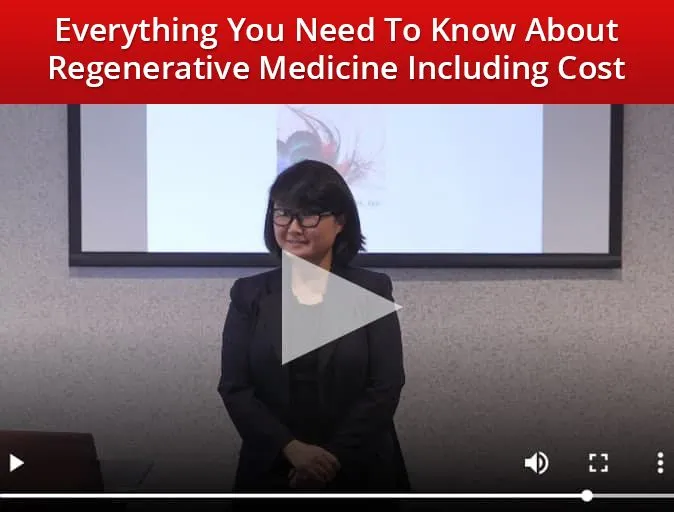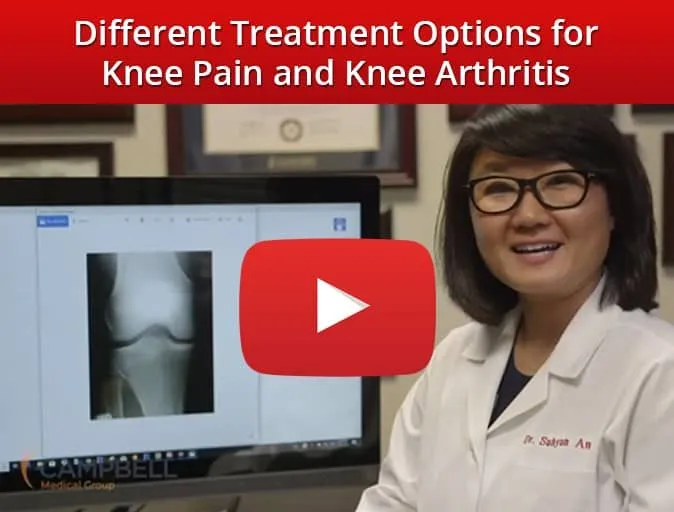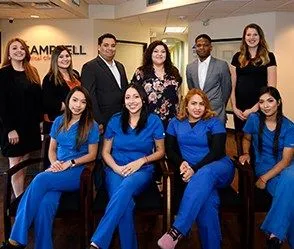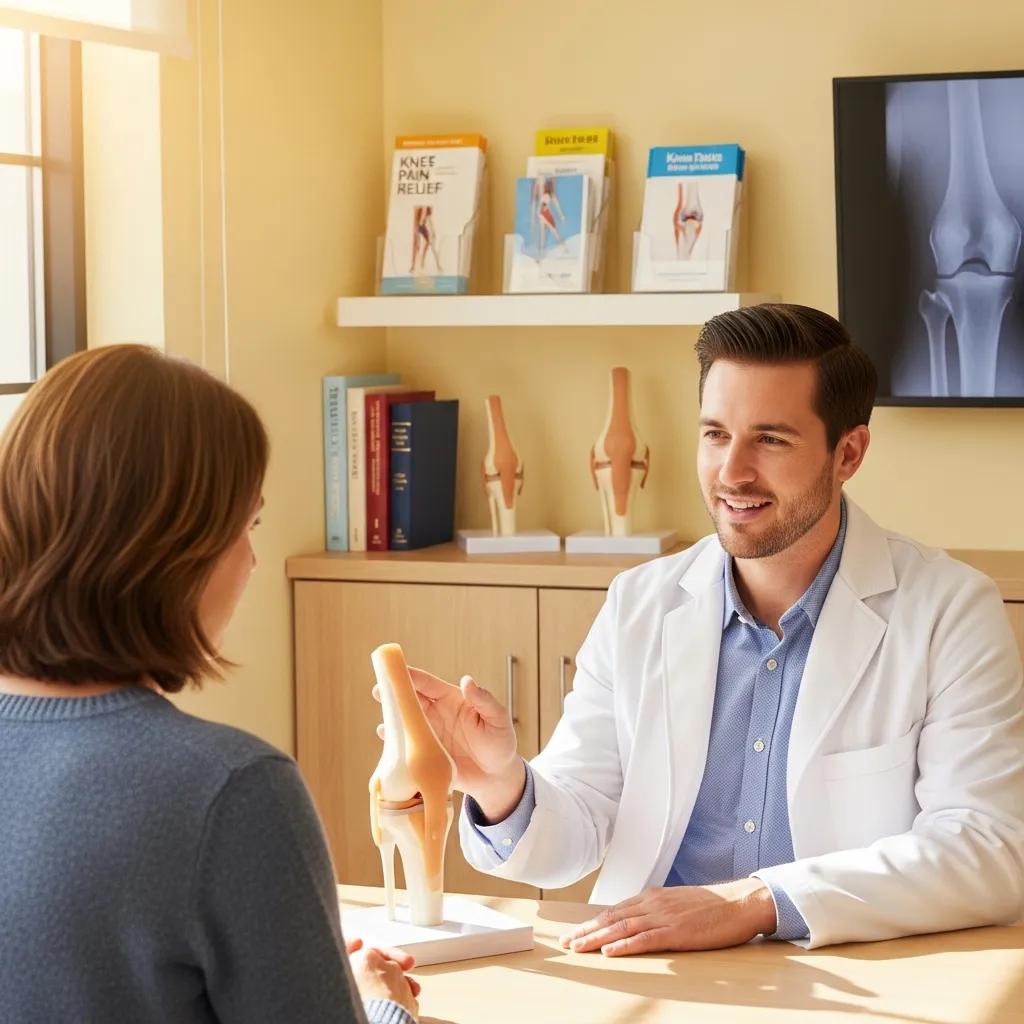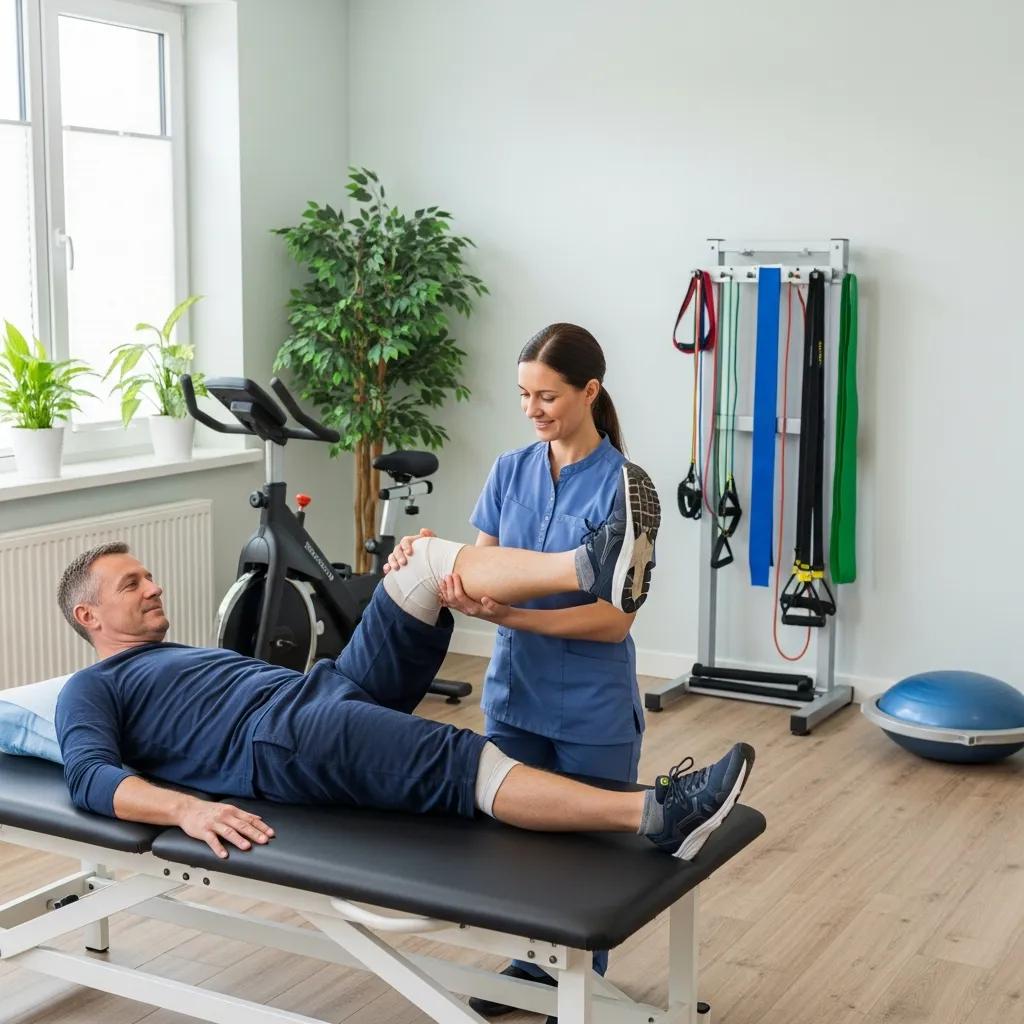
Comprehensive Non-Surgical Care for Knee, Shoulder & Neuropathy Pain
Chronic joint and nerve pain can steadily limit activity, disrupt sleep, and change how you live day to day; this article focuses on non-surgical knee pain treatment in Houston while also addressing broader chronic pain solutions. You will learn what chronic pain is, why conservative and regenerative approaches can restore function, and how modern non-surgical therapies work to reduce pain and improve mobility. This guide centers on evidence-informed regenerative medicine — including PRP, stem cell approaches, and regenerative cellular tissue — and explains adjunctive options like shockwave, PEMF, spinal decompression, and chiropractic care. The goal is to give clear steps for evaluation, realistic timelines for recovery, and actionable choices so patients can avoid unnecessary surgery when appropriate. Sections below define chronic pain, describe regenerative mechanisms, map conditions to treatments, outline advanced non-surgical therapies used in Houston clinics, explain how to start with a low-cost evaluation, and answer common patient questions. Throughout, keywords such as regenerative medicine Houston, PRP therapy Houston, and non-surgical knee pain relief Houston are integrated to help local patients find practical, medically grounded options.
What Is Chronic Pain and How Does It Affect Your Life?
Chronic pain is pain that persists beyond normal tissue healing time, typically lasting longer than three months, and it reflects ongoing biological drivers such as inflammation, structural degeneration, or nerve dysfunction. The mechanism often includes persistent nociceptive signaling, central sensitization, and altered tissue repair, leading to reduced mobility and ongoing discomfort that limits activity. A clear benefit of diagnosing chronic pain accurately is that targeted non-surgical strategies can address root contributors rather than only masking symptoms, which supports longer-term function and quality of life. Understanding types of chronic pain helps patients and clinicians match therapies precisely, and the next subsection lists the common types most relevant to Houston patients seeking knee and neuropathy care.
What Are the Common Types of Chronic Pain?
Common chronic pain types include joint (osteoarthritis), neuropathic (peripheral neuropathy and radicular pain), and axial or mechanical back pain, each with distinct symptoms, mechanisms, and treatment implications. Joint pain from osteoarthritis typically produces stiffness, swelling, and functional decline driven by cartilage wear and low-grade inflammation; matching regenerative options to disease stage is important for outcomes. Neuropathic pain often feels burning, tingling, or numbness and arises from nerve damage or metabolic causes like diabetes; nerve-targeted regenerative therapies and PEMF can be part of a multimodal plan. Axial and radicular back pain produce localized low back pain or radiating leg symptoms when nerves are irritated; accurate diagnosis by exam and imaging determines whether decompression, injections, or rehab are appropriate. These distinctions inform treatment selection and set expectations for recovery and functional improvement.
Cell Therapy and Tissue Engineering for Cartilage Repair and Osteoarthritis
Articular cartilage injuries, arising from traumatic, mechanical, and/or progressive degeneration, lead to pain, swelling, subsequent loss of joint function, and ultimately osteoarthritis. Due to the tissue’s unique avascular structure, chondrocytes, the sole cellular phenotype in cartilage, receive nutrition via diffusion from the synovial fluid, thereby limiting their intrinsic healing capacity. The initial cellular approach investigated for cartilage repair involved the in situ transplantation of isolated chondrocytes. More recently, an enhanced alternative to the aforementioned reparative strategy has emerged, involving the infusion of mesenchymal stem cells (MSCs). These cells possess self-renewal capabilities, exhibit chondrogenic differentiation potential, and can produce a wide range of growth factors, cytokines, and extracellular matrix components crucial for cartilage development. Beyond these primary reparative options currently in use, other…
Cell therapy and tissue engineering approaches for cartilage repair and/or regeneration, R Mardones, 2015
How Does Chronic Pain Impact Daily Activities and Quality of Life?
Chronic pain commonly reduces mobility, complicates routine tasks like walking and climbing stairs, and interferes with work, sleep, and social participation, creating a cumulative burden on mental health and independence. Functionally, people often limit activity to avoid pain, which can cause deconditioning and further weakness, while poor sleep and mood changes amplify pain perception through biological pathways. Economically, chronic pain contributes to lost workdays and increased healthcare utilization, making early, targeted interventions valuable for preserving function and reducing long-term costs. Addressing root causes through diagnostic testing and personalized non-surgical plans can restore activity and mental well-being while reducing reliance on long-term medications.
Why Choose Non-Surgical Solutions for Chronic Pain Relief?
Non-surgical approaches prioritize preserving anatomy, reducing downtime, and minimizing risks associated with operative care while offering pathways to meaningful symptom relief and improved function. The reasons include faster recovery, lower complication risk, and the ability to combine biologic injections, physical rehabilitation, and adjunctive modalities to target healing and pain modulation directly. Many patients are appropriate candidates for conservative care, and early intervention with regenerative and supportive therapies can delay or avoid surgery for those with mild-to-moderate structural changes. Choosing non-surgical strategies allows staged care with measurable goals and objective reassessment, which aligns treatment intensity to patient response and activity goals.
How Does Regenerative Medicine Houston Offer Effective Chronic Pain Relief?
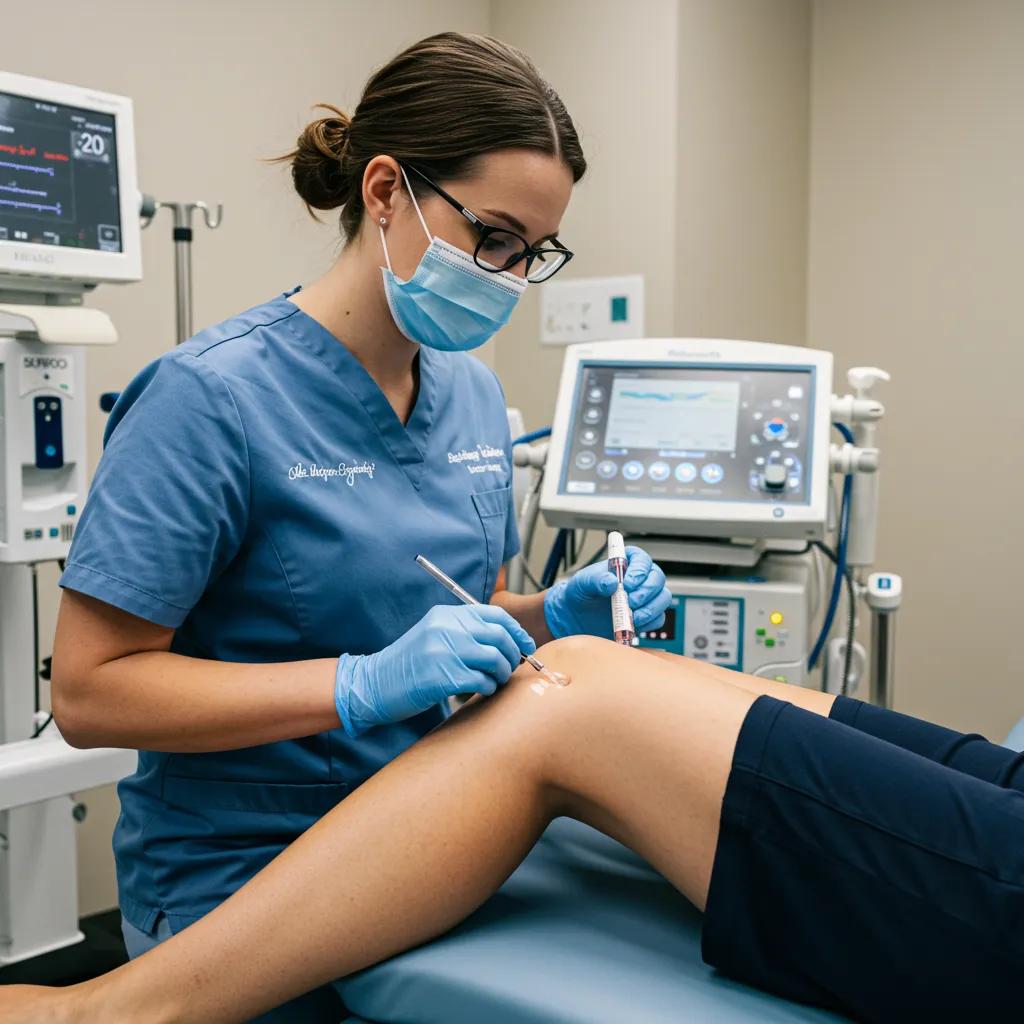
Regenerative medicine uses biologic agents and targeted interventions to modulate inflammation, stimulate tissue repair, and restore function without open surgery, resulting in reduced pain and improved mobility for many musculoskeletal and nerve conditions. The mechanism centers on delivering concentrated cellular components, growth factors, or signaling molecules to injured tissues to accelerate healing and remodel pathological processes. Primary benefits include symptom reduction, enhanced tissue resilience, and reduced dependence on long-term pain medications; clinicians select specific regenerative modalities based on diagnosis, severity, and patient health. The table below compares common regenerative therapies to clarify indications, session counts, recovery timelines, and evidence considerations.
Regenerative therapies available in Houston clinics provide localized biological support to injured joints and nerves, and Campbell Health Center offers several of these regenerative options as part of personalized care plans for local patients seeking non-surgical solutions.
| Therapy | Mechanism | Typical Indications | Typical Sessions / Recovery | Evidence Level |
|---|---|---|---|---|
| PRP (Platelet-Rich Plasma) | Concentrated autologous platelets release growth factors that reduce inflammation and stimulate repair | Tendinopathies, early to moderate osteoarthritis, some neuropathies | 1–3 injections, recovery days to weeks | Emerging to moderate clinical evidence |
| Stem Cell / Regenerative Cellular Tissue | Cellular signaling and trophic factors modulate inflammation and support larger-scale tissue repair | Moderate degenerative joint disease, complex soft tissue injuries | Often 1–2 procedures with progressive improvement over months | Variable evidence; ongoing research |
| Regenerative Cellular Tissue | Allogeneic or processed cellular products provide biological signaling to enhance healing | Patients seeking minimally invasive alternatives for joint degeneration | Single or staged applications; recovery weeks to months | Early to moderate; clinician-dependent protocols |
This comparison highlights how each approach targets healing differently and informs realistic expectations: PRP tends to act faster for inflammation reduction, while cellular therapies may produce more gradual structural benefits over months. After selecting a modality, clinicians integrate adjunctive therapies to support recovery and optimize outcomes.
What Is Regenerative Medicine and How Does It Work?
Regenerative medicine harnesses biologic materials and targeted delivery to reduce harmful inflammation and activate cellular pathways that support tissue repair, resulting in functional gains and pain reduction. Mechanistically, injections and biologic implants modulate local immune responses, increase growth factor signaling, and recruit resident repair cells to injured tissue, which can restore structure and reduce nociceptive drive. For patients, the practical result is improved function, less pain during daily activities, and the possibility of resuming prior levels of activity without major surgery. Understanding these mechanisms clarifies why regenerative options may be preferable for patients who want to preserve joint anatomy and avoid operative risks.
How Do Stem Cell Therapy and PRP Therapy Help Joint and Nerve Pain?
PRP delivers a concentrated sample of a patient’s platelets to an injured area, releasing growth factors that reduce inflammation and stimulate repair, while stem cell or regenerative cellular tissue therapies provide cellular signaling that can support more complex tissue remodeling. PRP is often favored for tendinopathies and early osteoarthritis where inflammation is a dominant feature, and it typically produces symptom relief within weeks to a few months. Stem cell and regenerative cellular tissue approaches may be chosen for larger structural deficits or when clinicians aim for broader regenerative signaling; improvements often unfold over one to three months and may continue longer. Both strategies are paired with rehabilitation and adjunctive therapies to maximize functional recovery.
What Are the Benefits of Regenerative Cellular Tissue Treatments?
Regenerative cellular tissue treatments offer patients reduced pain, improved joint or nerve function, and the potential to delay or avoid surgery by promoting biologic repair rather than removing or replacing tissue. Practical benefits include shorter recovery windows than many surgeries, lower immediate procedural risk, and reduced long-term medication reliance when successful. Durability varies by condition and patient factors, but many experience sustained symptom improvement over months to years with appropriate follow-up and adjunctive care. Clinician assessment of candidacy remains essential to match realistic outcomes to patient goals.
How Safe and Natural Are These Non-Surgical Treatments?
Most regenerative options use autologous material like PRP derived from a patient’s own blood, which reduces immune risk, while other regenerative cellular tissue products are processed under clinical protocols to ensure safety and sterility. Common short-term side effects include transient swelling, localized soreness, and mild inflammation at the injection site, which typically resolve within days to weeks; clinics perform screening and imaging to minimize risks. Safety improves when experienced clinicians follow standardized preparation and delivery protocols and when diagnostic testing confirms appropriate candidacy. Patients should discuss potential benefits and risks in a dedicated consult to make an informed decision about regenerative care.
Which Specific Conditions Can Houston Non-Surgical Treatments Address?
Houston non-surgical treatment options address a range of musculoskeletal and neuropathic conditions by matching diagnosis to therapies that target inflammation, tissue repair, or nerve modulation rather than defaulting to surgery. Typical conditions treated include knee osteoarthritis and tendon injuries, shoulder and hip degenerative or overuse problems, peripheral neuropathy, herniated discs and radiculopathy, and inflammatory arthritis symptoms to reduce pain and restore function. The next table helps readers match common conditions to appropriate non-surgical options, typical candidate characteristics, and expected outcomes to set realistic expectations.
| Condition | Non-Surgical Options Offered | Typical Candidate | Expected Outcomes |
|---|---|---|---|
| Knee osteoarthritis | PRP, regenerative cellular tissue, shockwave, PEMF, targeted rehab | Early to moderate OA, active patients seeking joint preservation | Pain reduction, improved mobility, delay of surgery |
| Shoulder pain (rotator cuff/tendinopathy) | PRP, shockwave, PEMF, chiropractic-assisted rehab | Tendinopathy or partial tears without large structural loss | Reduced pain, improved function with rehab |
| Peripheral neuropathy | Regenerative injections, PEMF, diagnostic-driven care | Diabetic or idiopathic neuropathy with sensory symptoms | Symptom reduction, improved nerve sensation over months |
| Herniated disc / radiculopathy | Spinal decompression, targeted injections, rehab | Selected patients without progressive neurological deficits | Reduced radicular pain, improved function; surgical referral if red flags |
How Is Knee Pain Treated Without Surgery in Houston?
Non-surgical knee care in Houston commonly integrates biologic injections (PRP or regenerative cellular tissue), shockwave therapy, PEMF, targeted chiropractic and rehabilitation programs, and activity modification to restore function. Treatment selection depends on osteoarthritis stage, ligament or meniscal integrity, patient age, and activity goals; early OA favors regenerative injections plus rehab, while advanced structural failure may still require surgical consultation. Typical course for injection-based care involves 1–3 sessions of PRP or a single regenerative application with progressive rehabilitation over weeks; adjunctive modalities like shockwave can accelerate tendon healing. Patients who do not respond to conservative care after appropriate trials are evaluated for surgical options, ensuring decisions are based on objective progress and shared decision-making.
What Are the Non-Surgical Options for Shoulder and Hip Pain Relief?
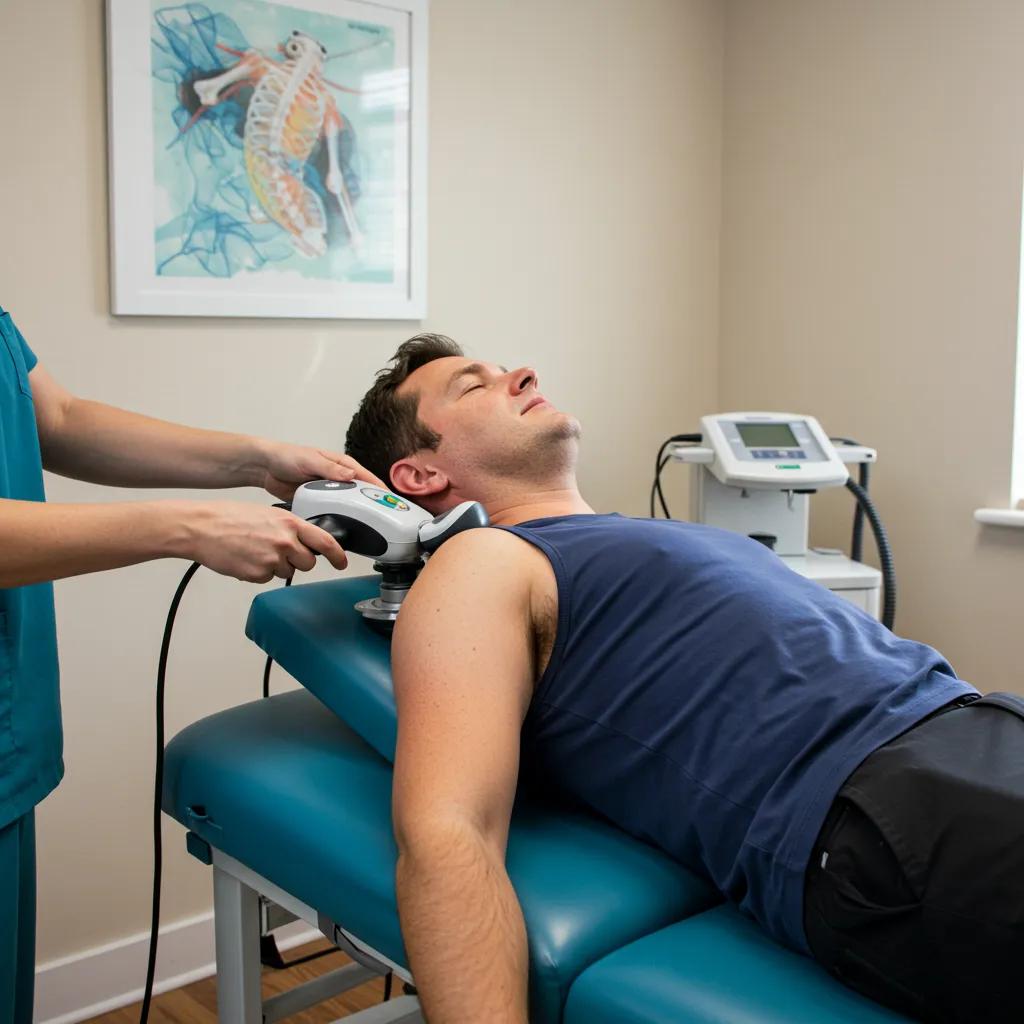
Shoulder and hip non-surgical care uses a combination of PRP or regenerative injections for tendon and labral pathology, shockwave and PEMF as adjuncts to stimulate tissue healing, and focused rehabilitation to restore range and strength. PRP injections are frequently used for rotator cuff tendinopathy and partial tears, while regenerative cellular approaches may be considered for degenerative labral or articular surface issues when appropriate. Shockwave therapy supports neovascularization and tendon remodeling, and PEMF can help modulate local inflammation and nerve symptoms; coordinated rehab reinforces biomechanical improvements. These combined approaches aim to reduce pain and restore joint function while avoiding invasive surgery when possible.
How Can Neuropathy Treatment Houston Non-Surgical Improve Nerve Pain?
Non-surgical neuropathy care focuses on diagnosing the underlying cause, then using regenerative injections, PEMF therapy, and medication-sparing strategies to improve nerve function and reduce symptoms. Mechanistically, regenerative injections and PEMF aim to modulate inflammation around nerves, encourage repair signaling, and improve microcirculation, which can lessen burning and numbness over time. Patients with diabetes-related neuropathy often benefit from diagnostic-driven plans that include metabolic optimization alongside targeted therapies to maximize nerve recovery. Expected improvements vary but commonly occur over weeks to months, and ongoing follow-up and supportive care help sustain gains.
What Are the Alternatives for Chronic Back Pain Treatment in Houston?
Non-surgical back pain strategies include spinal decompression for disc-related pressure, regenerative injections for disc or facet syndromes, chiropractic care for alignment and mobility, and shockwave or PEMF for paraspinal tendon issues, all selected based on specific diagnosis. Herniated discs with radiculopathy may respond to decompression and targeted biologic injections if there are no progressive neurological deficits, while degenerative disc disease may benefit from regenerative cellular approaches combined with rehab. Red flags such as progressive weakness or bowel/bladder changes prompt surgical referral, but many patients can find meaningful pain relief through staged, non-surgical care pathways. Coordinated multimodal plans improve outcomes and functional restoration.
How Does Campbell Health Center Treat Arthritis and Peripheral Neuropathy?
Campbell Health Center approaches arthritis and peripheral neuropathy with diagnostic-driven, non-surgical care that combines regenerative injections, PEMF, shockwave therapy, and targeted rehabilitation tailored to each patient’s goals and imaging findings. The clinic emphasizes minimizing long-term medications and preserving joint function by using biologics where appropriate and integrating adjunctive modalities to support healing and nerve function. Evaluation includes focused history, physical exam, and imaging to personalize therapy and measure progress, with the $49 consultation serving as the entry point for diagnosis and planning. Patients receive a clear pathway that balances symptom control with biologic strategies aimed at addressing underlying mechanisms.
What Advanced Non-Surgical Therapies Does Campbell Health Center Offer?
Advanced non-surgical therapies include shockwave therapy, PEMF, spinal decompression, chiropractic care, and diagnostic testing, each functioning as a distinct tool to address pain drivers and improve tissue health without surgery. These modalities can be combined with regenerative injections to amplify healing, control inflammation, and restore movement patterns essential for long-term outcomes. Understanding the role of each therapy helps patients and clinicians craft efficient, measurable plans that align with recovery timelines and activity goals. The subsections below explain mechanisms, typical courses, and how diagnostics shape personalized protocols.
How Does Shockwave Therapy Support Pain Relief and Healing?
Shockwave therapy uses focused mechanical energy to stimulate local biological responses such as increased blood flow, neovascularization, and metabolic activity in chronic tendon and soft tissue conditions, which supports tissue remodeling and pain reduction. Typical indications include chronic tendinopathies around the knee, shoulder, and plantar fascia where conservative care has plateaued; session counts commonly range from three to six treatments spaced over weeks. Patients often experience progressive pain reduction and improved function as remodeling occurs, and combining shockwave with regenerative injections and rehabilitation increases the likelihood of durable improvement. Shockwave’s non-invasive nature and ability to target focal pathology make it a valuable adjunct in multimodal plans.
What Is PEMF Therapy and How Does It Help Chronic Pain?
PEMF (pulsed electromagnetic field) therapy delivers low-level electromagnetic fields that modulate cellular activity, reduce inflammation, and support tissue repair at a cellular level, making it useful for neuropathic pain and chronic inflammatory conditions. Clinically, PEMF is an adjunct that can improve nerve conduction and decrease chronic inflammatory signaling when used alongside regenerative injections and rehabilitation. Typical PEMF courses involve multiple sessions over several weeks, with symptom modulation often reported after a few sessions and continued gains with consistent use. As a non-invasive modality, PEMF complements other therapies by enhancing cellular responsiveness to biologic treatments.
How Does Spinal Decompression Provide Relief for Herniated Discs?
Non-surgical spinal decompression applies controlled traction to reduce disc pressure, potentially retracting herniated material and relieving nerve root irritation that causes radicular leg pain, with the mechanism rooted in reducing mechanical compression and improving disc hydration. Candidate selection is critical: patients without progressive neurological deficits and with discogenic pain often experience reduced radicular symptoms and improved function after a prescribed series of decompression sessions. Integration with targeted rehabilitation and, when appropriate, regenerative injections can address both mechanical and biological contributors to back pain. Outcomes improve when decompression is part of a comprehensive plan tailored to diagnostic findings.
How Is Chiropractic Care Integrated Into Chronic Pain Management?
Chiropractic care focuses on restoring spinal alignment, joint mobility, and functional movement patterns, acting as a structural and functional complement to biologic and adjunctive therapies in multidisciplinary non-surgical care. Goals include improving range of motion, reducing mechanical stressors, and enhancing rehabilitation outcomes so regenerative treatments can be more effective. Safety considerations include careful assessment to ensure manipulative care is appropriate for the diagnosis, and coordination with injection-based therapies enhances overall recovery. Long-term maintenance strategies commonly incorporate periodic functional checks, targeted exercises, and activity modification to sustain gains.
What Diagnostic Testing Is Used to Personalize Treatment Plans?
Diagnostic testing — including focused physical exam and X-rays obtained during evaluation — identifies structural drivers, rules out red flags, and guides selection of regenerative, decompression, or rehabilitative therapies to maximize benefit. Imaging clarifies joint alignment, degeneration severity, and gross structural abnormalities, while clinical testing localizes nerve involvement and functional deficits; together they inform candidacy and procedural targeting. At many clinics the initial evaluation includes these diagnostic steps to create measurable treatment goals and track progress objectively. Accurate diagnostics reduce unnecessary procedures and improve the chance of matching the right therapy to the right patient.
How Can Patients Start Their Journey to a Life Without Chronic Pain in Houston?
Starting a non-surgical pain care pathway involves clear steps from first contact through evaluation, diagnosis, personalized planning, and follow-up, which reduces uncertainty and accelerates access to appropriate therapies. The recommended pathway below outlines actionable steps patients can follow to move from pain-limited function toward measurable improvement with staged interventions. A low-cost consult with imaging serves as the primary entry point to determine candidacy and develop a realistic timeline for recovery.
- Book a low-cost consultation to discuss symptoms and goals with a clinician.
- Complete an evaluation that includes clinical history, physical exam, and X-rays to establish a diagnosis.
- Receive a personalized treatment plan that may include regenerative injections, adjunctive therapies, and rehabilitation.
- Begin therapy with scheduled follow-up visits to monitor progress and adjust the plan as needed.
These steps create a structured pathway so patients know what to expect at each stage, and the next subsection explains exactly what happens during the typical initial consult and evaluation.
What Happens During the $49 Consultation and Evaluation?
The $49 consultation provides focused clinical history taking, a hands-on physical exam, and diagnostic X-rays as part of an efficient visit to establish diagnosis and candidacy for non-surgical therapies. During the visit the clinician assesses symptom patterns, functional limitations, prior treatments, and reviews imaging to determine whether regenerative options or decompression are appropriate; the goal is to create a clear, personalized plan. Patients leave the consult with an explanation of their diagnosis, treatment options, estimated timelines, and next steps for scheduling therapies. This low-cost consult reduces barriers to evaluation and enables informed decisions about individualized care.
How Are Personalized Treatment Plans Developed for Each Patient?
Personalized plans are built from a decision process that weighs diagnosis, imaging findings, patient age and activity goals, comorbidities, and evidence for specific therapies to align treatment intensity with realistic outcomes. Clinicians consider which modalities best target the primary pain drivers — inflammatory, degenerative, or nerve-related — and combine therapies for synergistic effect. Early diagnostic evaluation enables targeted care and increases the chance of improved function without surgery. For personalized guidance, scheduling an evaluation helps match treatments to realistic recovery timelines.
What Are Patient Success Stories and Testimonials from Houston?
Authentic patient stories illustrate practical outcomes such as improved pain scores, enhanced walking tolerance, and restored daily activities after structured non-surgical care, using clear metrics and timelines to show results. Helpful case summaries include the initial problem, diagnostic findings, the treatment sequence used, and objective improvement measures such as pain scale reduction or regained mobility benchmarks. Including local patient identity and measurable outcomes builds trust and helps prospective patients set realistic expectations for their own recovery. Clinics often present case-based evidence to help new patients understand typical timelines and likely benefits.
How Can You Schedule Your Non-Surgical Pain Relief Consultation?
Scheduling is typically done through a clinic’s appointment system or website and requires bringing relevant medical records and a list of current medications to the initial visit to streamline evaluation. Prepare to discuss symptom history, prior imaging, and activity goals so the clinician can efficiently assess candidacy and recommend appropriate diagnostics and therapies. The clinic’s low-cost consultation provides quick access to evaluation and X-rays to determine the right next steps, and staff can assist with booking follow-up treatments and providing preparation instructions. Patients should plan on a focused visit that results in a clear plan and scheduling options for their personalized care.
What Are the Most Common Questions About Non-Surgical Chronic Pain Treatments?
Common patient questions often concern which treatment is best, timelines for improvement, insurance coverage, comparisons to surgery, and how to find a trusted local provider; clear, concise answers reduce confusion and facilitate informed decisions. Below are direct-answer style responses optimized for quick understanding and follow-up guidance so readers can act with confidence.
| Question | Short Answer | Follow-up Resources |
|---|---|---|
| What is the best treatment for chronic pain without surgery? | The best treatment depends on the specific diagnosis; many patients start with regenerative injections combined with rehab and adjunctive modalities. | Schedule diagnostic evaluation to determine individualized plan. |
| How long does it take to see results from regenerative medicine? | Results vary: PRP often shows improvement within weeks to three months; cellular therapies may take one to three months or longer. | Monitor progress through scheduled reassessments with the clinician. |
| Are non-surgical treatments covered by insurance or Medicare? | Coverage varies; many regenerative procedures may be self-pay, and clinics may operate independent of insurance. | Verify your plan benefits and request a cost estimate during consult. |
| How do non-surgical options compare to traditional surgery? | Non-surgical care has lower downtime and risk but may be less effective for end-stage structural damage; surgery is sometimes necessary for definitive repair. | Use shared decision-making with imaging and functional goals to decide. |
What Is the Best Treatment for Chronic Pain Without Surgery?
There is no single “best” treatment for all chronic pain; the optimal approach depends on diagnosis, imaging, patient goals, and response to initial therapy, with regenerative injections, physical therapy, and adjunctive modalities commonly forming first-line plans. Clinicians favor interventions that address the dominant pain driver — inflammation, structural degeneration, or nerve dysfunction — and combine therapies for synergistic effect. Early diagnostic evaluation enables targeted care and increases the chance of improved function without surgery. For personalized guidance, scheduling an evaluation helps match treatments to realistic recovery timelines.
How Long Does It Take to See Results from Regenerative Medicine?
Timelines vary: many patients notice symptom changes within weeks after PRP, with more consistent improvement within two to three months; stem cell or regenerative cellular approaches often show gradual gains over one to three months or longer. Patient factors such as age, severity of degeneration, metabolic health, and adherence to rehabilitation influence speed and magnitude of response. Clinicians schedule follow-ups to assess progress and adjust adjunctive treatments to accelerate recovery. Clear expectations and objective measures help patients track improvement and maintain engagement.
Are Non-Surgical Treatments Covered by Insurance or Medicare?
Coverage for regenerative therapies is often variable; many regenerative procedures may not be covered and are offered on a self-pay basis, and some clinics operate independently of insurance and Medicare to provide flexible, personalized care. Patients are encouraged to verify plan benefits in advance and use the initial consult to obtain a cost estimate and discuss financing options if needed. Clinics that operate outside insurance frameworks can offer transparent pricing and timely access to diagnostics and therapies. A consult visit is the most efficient way to clarify coverage and out-of-pocket expectations.
How Do Non-Surgical Options Compare to Traditional Surgery?
Non-surgical options generally involve lower immediate risk, shorter recovery, and preservation of native anatomy, making them attractive for early to moderate disease and patients prioritizing faster return to activity. Surgery can be definitive for severe structural damage but involves higher complication and recovery risks; when non-surgical care fails or structural integrity is compromised, surgical referral is appropriate. Shared decision-making using diagnostics, functional goals, and realistic outcome data helps determine whether conservative or operative pathways best match a patient’s needs. Combining non-surgical treatments can often delay surgery while improving quality of life.
How Do I Find a Trusted Pain Doctor in Houston?
Look for clinicians with experience in regenerative therapies, transparent treatment pathways, clear outcome expectations, and accessible local patient feedback; credentials and a structured diagnostic approach are key indicators of trustworthy care. Questions to ask include experience with the specific procedure, measurable outcomes, and how the clinic integrates diagnostics and follow-up into care plans. Accessibility, local availability, and clear communication about candidacy and costs help ensure a good fit. Scheduling an initial consult allows direct assessment of clinician expertise and personalized recommendations.
Why Choose Campbell Health Center for Your Houston Chronic Pain Relief?
Campbell Health Center provides a patient-focused, diagnostic-driven, non-surgical approach to chronic pain that emphasizes safe, natural regenerative therapies, adjunctive modalities, and personalized plans independent of insurance constraints. The clinic’s model prioritizes root-cause care with options designed to minimize medications and avoid unnecessary surgery when appropriate, and it offers a low-cost $49 consultation that includes evaluation and X-rays to start the diagnostic and treatment planning process. Led clinically by Dr. Suhyun An, DC, MSN, NP-C, the team focuses on individualized care pathways for Houston patients seeking regenerative and advanced non-surgical solutions. For local patients interested in evaluation, the clinic is located at 1012 Campbell Rd, Houston, TX 77055 and scheduling is available by contacting the clinic directly or using their online appointment channels.
Who Is Dr. Suhyun An and What Is Her Expertise?
Dr. Suhyun An, DC, MSN, NP-C, leads clinical care at Campbell Health Center and brings a combined scope of practice that integrates chiropractic, advanced clinical assessment, and nurse practitioner–level medical decision-making for personalized non-surgical pain care. Her credentials reflect cross-disciplinary training that supports integrative plans combining regenerative interventions, diagnostic testing, and functional rehabilitation. Patients benefit from leadership that emphasizes thorough evaluation, evidence-informed choices, and coordination of adjunctive therapies to maximize functional outcomes. This integrated expertise supports tailored care plans for diverse chronic pain presentations.
What Makes Campbell Health Center’s Approach Unique?
Campbell Health Center’s approach blends regenerative medicine, adjunctive technologies, and functional rehabilitation in a personalized framework that emphasizes root-cause assessment and conservative care before considering invasive options. The clinic operates independent of insurance, which enables flexible treatment choices and focused clinician time for individualized planning, while offering a clear, measurable pathway from evaluation to therapy. Their combination of biologic options, PEMF, shockwave, spinal decompression, and chiropractic coordination creates multimodal plans designed to restore function and reduce long-term medication reliance. This patient-centered model facilitates shared decision-making and transparent expectations.
How Does Independent Care Without Insurance Improve Patient Experience?
An insurance-independent model allows clinicians to spend more time on evaluation and shared decision-making, to offer flexible treatment combinations without restrictive coverage constraints, and to present clear pricing options such as the $49 consult to streamline access to diagnostics. Practically, this means patients can obtain timely X-rays, a focused diagnostic plan, and specific recommendations without waiting on prior authorizations, enabling faster initiation of appropriate therapies. Transparency in care options and cost supports informed choices and ongoing adjustments based on response. The model emphasizes patient goals and clinically driven treatment rather than insurance coding constraints.
What Are the Clinic’s Location, Hours, and Contact Details?
Campbell Health Center’s physical location is 1012 Campbell Rd, Houston, TX 77055, where diagnostic evaluations, imaging, and non-surgical therapies are provided for local patients seeking regenerative and advanced pain care. For scheduling and appointment details, patients should contact the clinic directly through the clinic’s official appointment channels or refer to the clinic’s public scheduling resources to arrange the $49 consultation and evaluation. The $49 consult includes clinical assessment and X-rays to begin a personalized diagnostic and treatment plan tailored to each patient’s condition.

